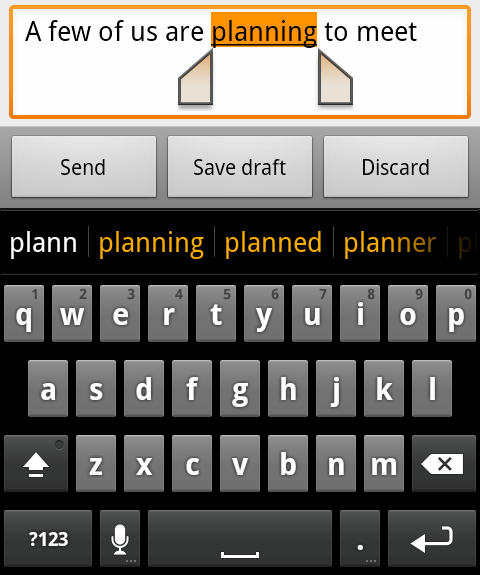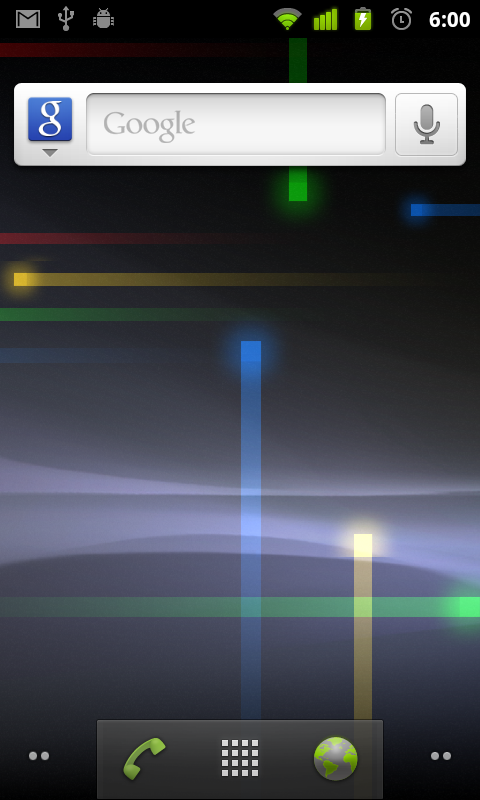A Busy Day for Android - Nexus S and Gingerbread (2.3) Officially Announced
by Brian Klug on December 6, 2010 9:35 PM EST- Posted in
- Smartphones
- Nexus S
- Android
- Mobile
What's new in Android 2.3
As expected, today Google announced Android 2.3 Gingerbread and the Nexus S. Android 2.3 is the latest iteration of Google’s popular smartphone platform, and includes a number of immediately apparent graphical changes to the Android 2.2 UI, and a host of under the hood features for developers. Alongside the Android 2.3 announcement came official confirmation of the Nexus S, which appears to be architecturally very similar to the Samsung Galaxy S line of devices, with the notable inclusion of near field communication (NFC) hardware, a curved display, and a front facing camera.
First up are new user features in Android 2.3, which there are a number of. Most notable among those are a host of UI changes which google claims are aimed at improving both speed, look, feel, and simplicity. The grey shade and notification bar is now solid black, and menu options appear to be either white or green on black. No doubt, this is done intentionally to help Android 2.3 finally leverage power savings of black (off) pixels on devices with AMOLED displays. There are additional changes in the settings application to make navigation easier, though it isn't immediately obvious what those changes are. Gingerbread’s UI brings GPU accelerated animations onboard and will likely provide some speedup to the interface which even with 2.2 was occasionally jittery even on the fastest hardware.
Gingerbread also brings a multitouch virtual keyboard with repositioned and reshaped keys for better targeting at high speeds. Multi-touch support on Gingerbread enables input such as shift+<letter> and ?123+<symbol>, long-press to select accented characters (which sounds almost identical to iOS's implementation) and of course just general accuracy improvement. Though most of the commercial platforms bundle Swype or a multitouch keyboard rolled by the device OEM (such as the Droid X and Droid 2), it's nice to see stock Android finally getting a better keyboard.

Along those lines also is improved word selection and one-touch copy-paste support. Press-holding on a word selects for copy and paste, and also enables free-selection mode which brings up handles for selecting much more text, which looks very similar to iOS' copy paste implementation. No trackball or cursor is needed in either selection or cursor mode, which is nice for devices (like the Droid X) which lack a trackball.


There are also improvements to power management and applications control. It's noted that the system now has the power to manage applications - even closing them if necessary - to ensure maximum battery life. From the screenshots provided, it appears that Gingerbread now provides a graph of charge and elapsed power-on time, as shown above. Note how directly below the graph is a timeline of screen-on events (shown with blue) and charge events (shown with a green highlight). It's nice to see users being given some more direct feedback to manage power consumption. Notably, this UI appears very similar to System Panel, an application I have running on all the Android devices that I come across.
There's now a link to the manage applications setting window from the options menu on the home screen. No doubt Google views applications manager as the built in task manager for Android (which it basically has been since day one) and wants people to use these tools to manage active applications and see memory footprint instead of third party task managers.

Gingerbread also adds SIP support for VoIP and internet based calling. Like other SIP supported devices, you need a SIP account and provider of your own, but that's nothing new if you're coming from a SIP-friendly platform.

The big thing Google has added support for is near-field communication (NFC) which enables the device to read information from smart tags and stickers. I'm left thinking that NFC is designed to augment and replace QR codes in the long term. NFC in general has a maximum bit rate of around 424 kbps/s and range of under 0.2 meters, though it's unclear what real-world performance and range will be for NFC tags and readers in smartphones. Expect to see a wave of NFC-enabled devices from RIM, Nokia, and even Apple.




















45 Comments
View All Comments
Bhairava - Monday, December 6, 2010 - link
Oh come on Google!!! No microsd slot? Really no microsd slot??NO MICROSD SLOT?
Really??? Is that true??
Oh come on, i cant believe that.
Jedi2155 - Monday, December 6, 2010 - link
Nothing special here for me other than Gingerbread and NFC. I prefer my Epic 4G although I'm saddened that they only provided Bluetooth 2.1+EDR on the Epic versus 3.0 on the rest of the galaxy phones. Its pretty insane on how different every carriers version of the Galaxy phone is.Bhairava - Monday, December 6, 2010 - link
Really no microsd slot?!? Really??Go to hell Google!!
ssj4Gogeta - Monday, December 6, 2010 - link
No one's forcing you to buy it, so what's the problem?TareX - Monday, December 6, 2010 - link
I was saving $600 for this phone. I can't believe I'm passing on the new Nexus... (aka, a Samsung Galaxy S with a flash, without a microSD slot)Gamingphreek - Tuesday, December 7, 2010 - link
For goodness sake, pay attention and read the article before reacting.It says no SD Card was INCLUDED. It doesn't say that there is no SD Card *slot*. All they are doing is bringing in support for devices that do not, in fact, have an SD Card slot.
A little reading comprehension goes a long way...
mesiah - Tuesday, December 7, 2010 - link
Actually, not to sound like an ass or anything, but a little research would show you that there is indeed no SD card slot on the nexus s. Brian may have been a little unclear, but he did say "Gingerbread brings official platform support for devices that lack external storage, instead allowing for internal NAND to be partitioned to emulate a virtual SD card. That appears to be what is done on the Nexus S - there’s no microSD card" So your reading comprehension comment was a little unwarranted.That being said, it is disheartening to see android devices move in this direction. an SD slot was always one of the selling points for an android device over an iphone. Although most people aren't going to use 16gb, people that have a large music library or store movies on their SD card are going to shy away from this phone.
Bhairava - Tuesday, December 7, 2010 - link
I agree, i have a 32gb sd on my galaxy 'couse i like to carry my music with me, and this lack on the Nexus S is a big big disappointment.Bhairava - Tuesday, December 7, 2010 - link
No you need to read better, and to let some smugness drop.Shadowmaster625 - Tuesday, December 7, 2010 - link
If you're going to blow $600 on a phone, then why not spend another $100 to buy a dedicated wireless portable storage device?